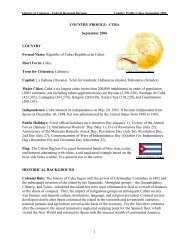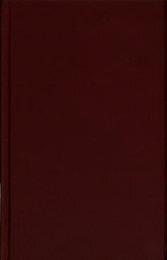Anton Webern's Six Pieces for Ocrhestra, op. 6, Arrangement for ...
Anton Webern's Six Pieces for Ocrhestra, op. 6, Arrangement for ...
Anton Webern's Six Pieces for Ocrhestra, op. 6, Arrangement for ...
Create successful ePaper yourself
Turn your PDF publications into a flip-book with our unique Google optimized e-Paper software.
17 In the Universal Edition print, the cello c of the orchestral version is given to the double<br />
bass, the result being a doubling with the c in the piano part.<br />
18 See the analysis by Nicolaus A. Huber, "Zu Weberns Kammerorchesterbearbeitung<br />
seiner Sechs Stücke für Orchester <strong>op</strong>. 6 für den Verein für musikalische<br />
Privataufführungen" in Schönbergs Verein für musikalische Privataufführungen (see note<br />
3), pp. 65-85.<br />
19 "Unfinished Theoretical Works," No. 10, Arnold Schoenberg Center, Vienna.<br />
20 Arnold Schoenberg, letter to Alexander Zemlinsky of February 20, 1918; Zemlinskys<br />
Briefwechsel mit Schönberg, Webern, Berg und Schreker (Briefwechsel der Wiener Schule,<br />
1), ed. Horst Weber, Darmstadt: Wissenschaftliche Buchgesell-schaft 1995, p. 187.<br />
21 In the domain of transcriptions (i.e. "soloistic" arrangements of large orchestral<br />
textures), a precedent can be found in Richard Wagner's Siegfried-Idyll <strong>for</strong> thirteen<br />
instruments (1870), the musical material of which was largely taken from the third act of<br />
his <strong>op</strong>era Siegfried; cf., with reference to the "soloistic instrumentation," Egon Wellesz,<br />
Die neue Instrumentation (Berlin: Max Hesse, 1928/9), vol. I, p. 32 and vol. II, p. 149.<br />
22 Letter to Heinrich Jalowetz of September 22, 1921, Heinrich Jalowetz Collection, Paul<br />
Sacher Foundation.<br />
23 Statement of aims of the Verein für musikalische Privataufführungen, February 1919;<br />
quoted from Joan Allen Smith, Schoenberg and His Circle (see note 3), p. 245.<br />
24 In other places, however, we find clear indications of a "soloistic" type of<br />
instrumentation.<br />
25 The second chord arises through contraction of the outer parts and addition of the central<br />
tone g-sharp; the third chord, reached by corresponding expansion of the outer voices, is<br />
identical with the first.<br />
26 The general downward motion contributes as much to this as to the widening of the<br />
ambitus, the move from three-part to four-part writing, and the gradual introduction of new<br />
pitch classes. For a discussion of this passage of <strong>op</strong>. 6, No. 4, see Paul Kabbash, "Form and<br />
Rhythm in <strong>Webern's</strong> Atonal Works" (Ph.D. diss., Yale University, 1983), pp. 98ff.<br />
27 Cf. Nikolay Rimsky-Korsakov, Principles of Orchestration, ed. Maximilian Steinberg,<br />
English trans. Edward Agate (New York: Dover, 1964), p. 35: "the flute...in its lowest<br />
register, recalls the pianissimo trumpet tone."<br />
28 Cf. Reinhold Brinkmann. "Die George-Lieder 1908/9 und 1919/23 - ein Kapitel Webern-<br />
Philologie," in Beiträge der Österreichische Gesellschaft für Musik '72/'73: Webern-<br />
Kongress (Kassel, 1973), pp. 43-50; Felix Meyer, "Im Zeichen der Reduktion:<br />
Quellenkritische und analytische Anmerkungen zu <strong>Anton</strong> Weberns Rilke-Liedern Op. 8,"



![Albert Einstein Papers [finding aid]. Library of Congress. [PDF ...](https://img.yumpu.com/21604228/1/190x245/albert-einstein-papers-finding-aid-library-of-congress-pdf-.jpg?quality=85)





![American Colony in Jerusalem Collection [finding aid]. Library of ...](https://img.yumpu.com/17941275/1/190x245/american-colony-in-jerusalem-collection-finding-aid-library-of-.jpg?quality=85)



![Piccard Family Papers [finding aid]. - American Memory - Library of ...](https://img.yumpu.com/17941234/1/190x245/piccard-family-papers-finding-aid-american-memory-library-of-.jpg?quality=85)


